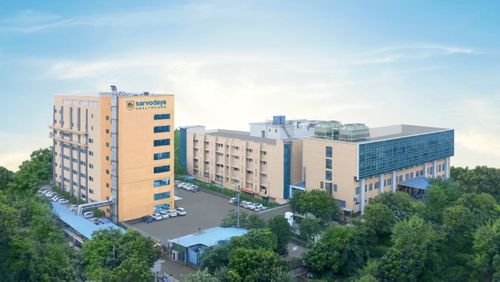Overview
At the Sarvodaya Institute of Robotic Surgery, general surgery has been redefined with the precision of the AI-powered Smart Surgical Robot, enabling a wide range of minimally invasive procedures with greater safety and faster recovery.
Whether it’s gallbladder removal, hernia repair, or gastrointestinal surgery, robotic-assisted techniques offer superior control and reduced postoperative discomfort. As the Best Robotic Surgery Hospital in Faridabad, we combine expert surgical hands with next-gen technology to deliver outcomes that are less painful, cosmetically better, and focused on quicker return to daily life.
Robotic Surgeries Performed
The surgery is performed for treating Inguinal, femoral, hiatal and other hernias, especially the ones located at difficult locations in the abdomen. The robot gives a 3D view inside the body that helps in precision, reduced blood loss and pain.
- Robotic Appendectomy (Appendix removal)
Performed to treat appendicitis or complications of an inflamed appendix. With robotic assistance, surgeons can remove the appendix precisely through small incisions, offering better visualisation and reduced complications.
- Robotic Cholecystectomy (Gallbladder removal)
Performed to treat gallstones, cholecystitis, or gallbladder dysfunction. Robotic assistance allows for safer removal through small incisions with reduced post-op pain.
- Robotic Nissen Fundoplication (for GERD and Hiatal Hernia)
A precise surgical solution for GERD and hiatal hernia, this procedure strengthens the lower oesophageal sphincter to prevent acid reflux and restores digestive comfort.
- Robotic Gastric Bypass (Bariatric Surgery)
Indicated for severe obesity, this procedure alters the stomach and small intestine to support weight loss and improve comorbid conditions like diabetes and sleep apnea.
- Robotic Colorectal Surgery
Used for colorectal cancers, IBD, diverticulitis, and rectal prolapse. Offers precise resection with faster recovery and minimal damage to surrounding tissues.
- Robotic Hemicolectomy (Colon removal)
Involves the removal of the right or left portion of the colon. Often indicated for colon cancer, diverticular disease, or inflammatory bowel conditions.
- Robotic Sigmoidectomy (Sigmoid Colon removal)
Performed to remove the sigmoid colon, especially in cases of diverticulitis, colorectal cancer, or IBD affecting this region.
Removal of diseased segments of the large or small intestine due to cancer, IBD, diverticular disease, obstruction, or trauma. Robotic precision supports better functional outcomes.
- Robotic Radical Hysterectomy (Uterus removal)
Performed to remove the uterus for treating uterine fibroids, abnormal bleeding, early-stage cervical cancer and certain gynecologic malignancies. Robotic assistance provides enhanced precision in removing the uterus, cervix, surrounding tissues, and lymph nodes.
- Robotic Pelvic Tumour Surgery
Performed to remove benign or malignant tumours in the pelvic region involving organs such as the bladder, uterus, prostate, or rectum. Robotic assistance allows surgeons to operate in the deep and narrow pelvic cavity with greater precision while preserving healthy structures and reducing complications.
- Robotic Radical Cystectomy (Bladder removal)
Performed to treat invasive bladder cancer or complex bladder conditions. With robotic assistance, the bladder is removed along with nearby lymph nodes and, in some cases, surrounding organs with superior precision and better functional outcomes compared to open surgery.
- Robotic Pelvic Lymph Node Dissection / Surgery
Performed to stage and treat cancers of the prostate, bladder, cervix, or uterus. Robotic assistance enables precise removal of lymph nodes from the pelvic region through small incisions, improving accuracy while minimising blood loss, complications, and recovery time.
Benefits of Minimally Invasive Robotic Surgery
-
Increased Precision: High-definition 3D vision and micro-level accuracy in complex surgeries.
-
Greater Flexibility: Extra degrees of motion for delicate and difficult procedures.
-
Minimally Invasive: Smaller incisions mean less scarring and trauma.
-
Lower Infection Risk: Reduced wound exposure decreases the chances of infection.
-
Less Blood Loss: Precise movements minimise bleeding and the need for transfusions.
-
Faster Recovery: Shorter hospital stays and quicker return to normal life.
-
Reduced Pain: Minimal tissue damage results in less post-operative discomfort.
-
Telesurgery Capabilities: Enables remote-assisted and advanced surgical options.











